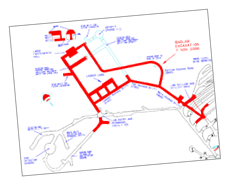
Deep underground laboratory for particle astrophysics
We have built a new, deep underground laboratory called SNOLAB, 6800 feet
underground at the SNO site near Sudbury. This facility will host a battery of
new experiments to address several unanswered questions about the properties of
neutrinos, and the nature dark matter and dark energy, and how these relate to
the origins of our universe. The underground laboratory is necessary to look
for the rare events that are signals for the neutrino and dark matter
interactions that are used to probe the cosmos.
Below are summaries of the different Queen's astroparticle experiments, many
of which take advantage of the SNOLAB facilities. See the individual project
home pages for more details and references to published papers.
Click here to see a video of SNOLAB
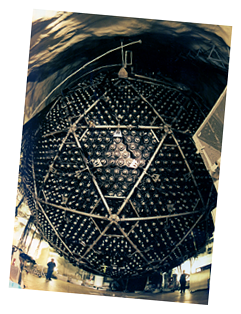
The Sudbury Neutrino Observatory
The SNO experiment was designed to look at neutrinos from the
sun and led to the discovery that neutrinos change flavour in passing from
the core of the sun to the earth.
Although SNO data acquisition stopped in November, 2006, data analysis
has continued and is nearly complete after the publication of several papers
extending the work on solar and atmospheric neutrinos.
Neutrinos may be the most common particle in the universe, yet they are also
among the most difficult to detect. The majority of neutrinos detected here on
earth are produced in the Sun by stellar burning processes (about 2% of the
total energy from the sun is emitted in the form of neutrinos), however they can
also be the result of radioactive decay, supernova explosions (where 99% of the
released energy is in the form of neutrinos), or as relics from the big
bang.
The SNO detector observed tiny flashes of light resulting from neutrino
interactions using an array of 9600 20cm-diameter photomultiplier tubes (PMTs)
each of which are sensitive to single photons. At the core of the detector was
1000 tonnes of heavy water which was used to detect neutrinos via three different
nuclear interactions. Through careful analysis, these measurements provide
insight into previously unknown properties of this elusive particle.

Dark matter search with superheated droplets
PICO is a direct dark matter search experiment. It uses the
superheated droplet detector technique to find evidence for dark matter in our
solar system. The experiment is located at SNOLAB in Sudbury, Ontario. The
Queen's group is involved in the design, installation, and operation of the
system. Queen's students are also at the forefront of the data analysis of
PICO WIMP search data.
Supersymmetry theories favored by particle physicists today predict the
existence of a stable heavy particle that only interacts weakly. These
particles are called WIMPs (weakly interacting massive particles).
PICO uses tiny (200μm) liquid droplets of freon suspended in a gel as
medium for detecting these WIMPs. The droplets are kept in a superheated state,
and when a WIMP hits a droplet the freon changes phase to a gaseous bubble.
This transition creates a shock wave that is detected by a piezo-electric
sensor.
A single detector has 9 piezo-electric sensors and contains 4.5 litres of
gel. The detectors are housed in a temperature-controlled enclosure and
surrounded with water shielding to reduce background radiation. Currently, 29
detectors are operational at SNOLAB, with plans to add 3 more.
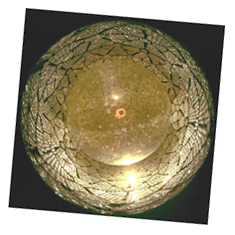
Liquid scintillator detector for low energy neutrinos
SNO+ is a project that is a follow-up to SNO. Using
most of the existing SNO detector but replacing the heavy water with a
"new" liquid scintillator made from linear alkylbenzene, SNO+ would be
sensitive to solar neutrinos with lower energies than SNO, and it
would also be able to detect antineutrinos produced by nuclear
reactors and by the decays of the natural radioisotopes present in the
Earth. This would give SNO+ the ability to make measurements that are
important not only to neutrino physics, but also to solar physics,
geophysics and geochemistry.
By measuring the survival probability of the pep solar neutrinos with
precision, SNO+ would probe the coupling between neutrinos and matter
in the region most sensitive to new phenomena. This could reveal the
presence of new physics such as non-standard couplings to new
particles, or the presence of sub-dominant effects in oscillations
from a sterile neutrino.
We can load the liquid scintillator with Tellurium, a double beta
decay isotope. With tonnes of Tellurium dispersed in the detector,
SNO+ could detect neutrino-less double beta decay. This would shed
light on the charge conjugation nature of the neutrino and on the
absolute neutrino mass scale, both impacting on our understanding of
the evolution of the Universe.
Queen's is one of the leaders in developing this project. The SNO+
Project Director is Queen's Faculty member Professor Mark Chen.
Mechanical construction during the transition, scintillator
purification, liquid scintillator optics, double beta decay,
calibration sources and hardware, detector and physics simulations and
analysis - there are opportunities to get involved in many aspects of
this project.
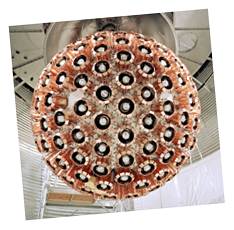
Dark matter search with liquid argon
With DEAP-1 with 7 kg of liquid argon, we have demonstrated a discrimination
of events that are backgrounds to the dark matter search (beta and gamma events)
in liquid argon at the level of 10-8. With this very low background
level, the 3600 kg DEAP-3600 detector is projected to be sensitive to
cross-sections down to 10-46cm2, and will increase the
current experimental sensitivity to dark matter particles by a substantial
factor.
Construction of the DEAP-3600 detector underground at SNOLAB (pictured) is
complete and the detector is currently taking data. The DEAP group at
Queen's is active in cryogenics design and construction, liquid argon
purification and scintillation studies, Monte-Carlo simulation, detector
calibration and analysis.
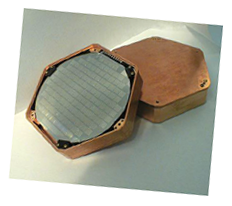
SuperCDMS Dark matter search with cryogenic detectors
The Cryogenic Dark Matter Search (CDMS) collaboration has develope cryogenic
semiconductor detectors to detect and identify the very rare interactions of
Weakly Interacting massive Paricles (WIMPs) - proposed to solve the long
standing dark matter problem - with atomic nuclei. The detectors are kept at
very low temperatures (40-50 mK) so the low energy of a WIMP interaction
still can cause a measurable increase in the detector temperature. With the
additional detection of an ionization signal from each interaction, these
detectors become very powerful in discriminating between ordinary radiation
such as environmental radioactivity and potential WIMP interactions.
SuperCDMS, the successor of CDMS is presently operating cryogenic germanium
detectors with a total mass of roughly 9 kg at the Soudan Underground
Laboratory in Minnesota. At the same time we are preparing for the next
phase of the experiment which aims at deploying detectors with a total mass
of hundreds of kilogram at sNOLAB. The main reason for moving to SNOLAB is
the considerably better shielding against cosmogenic radiation due to the
larger depth of the laboratory.
At Queen's we operate a cryogenic facility for detector R&D, and
characterization and testing of the new detectors being developed and
produced for SuperCDMS SNOLAB. We are also heavily invovled in data analysis
and Monte Carlo simulations. Queen's will paly a leading role for the
installation of the new setup at SNOLAB.
NEWS-G is an international collaborative project (Canada, France, Greece,
UK, US) primarily dedicated to the search for dark matter particles in the
GeV-subGeV mass range. The project involves the use of Spherical
Proportional Counters, which have specific advantages, such as the abilities
to use gas with very low atomic numbers (H, Ne, He), to discriminate signal
from background through fiducialistion, and to operate the detector with a
large range of parameters that can allow us to disentangle a possible signal
from background.
NEWS-G operates a 60 cm diameter detector at Laboratoire Souterrain de
Modane (France), which has already produced competitive results with Neon as
the target gas, and is preparing a large 140 cm diameter detector, which
will be embedded in a compact lead and PE shields, to be installed in SNOLAB
by the end of 2018.
Specific features of this kind of detectors -- low capacitance, low
threshold, excellent energy resolution, single readout channel (in its
simplest version), low cost, robustness, flexibility in gas choice and
operating pressure -- have led to us to envisage other applications, such as
Coherent Elastic Nuclear Neutrino Scattering study, Double Beta decay
search, and gamma ray and neutron spectroscopy.
The Queen's University group is the strongest group of the collaboration,
and plays a major role in the development and execution of NEWS-G, thanks to
significant CERC and CFI grants held by Gilles Gerbier. Activities at
Queen's involve design, simulations, detector building, testing, physics
analysis, and skills to reduce background in detectors, and to understand
and optimise detector response.
^
CUTE
CUTE is a Queen's University project involving a dilution refrigerator
able to hold and operate about 10kg of detectors at mK temperature, within a
set of water and lead shields to protect from external radiation. It is
currently being installed in SNOLAB. CUTE is primarily meant to be a testing
facility for SuperCDMS detector towers, which will be eventually used in the
large SuperCDMS cryostat, currently being designed, to be installed by
2021.
Led and financed primarily by Gilles Gerbier thanks to the CERC grant,
the project also involves faculty Wolfgang Rau. The CUTE team is growing and
involves now about 7 members including Research scientist, Post-Doctoral
fellow, and Master/PhD students.
^
QHEAT
The Queen’s High Energy and Astroparticle Theory group (QHEAT) explores
many open questions in fundamental physics including the nature of dark
matter, the origin of the matter-antimatter asymmetry, new properties of
neutrinos and new physics at the terascale and beyond. We are particularly
interested in early universe cosmology, high-energy astrophysics, and novel
observational signatures at underground and large-volume experiments. More
information can be found on our website which will be coming soon.
If you have questions or comments about the content of this website, please contact
qusno@sno.phy.queensu.ca.